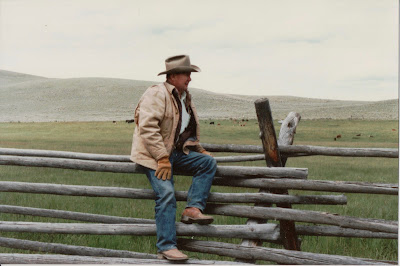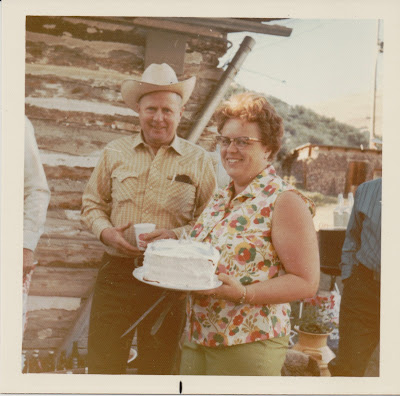My grandfather, George Marvin Lloyd, was my mother’s father. He was also known as “Pinky” or Marvin as his father was George Martin Lloyd.
Pinky on his horse
Marvin was born on 21 June 1896 in Walla Walla County, Washington. After attending school in Waitsburg, Washington, he attended classes at Washington State College in Pullman, Washington. He continued his education with a business college course in Portland, Oregon and returned to Waitsburg working at First National Bank as bookkeeper. He married Mary Caroline (Calla) Summers on 15 August 1918. They lived in Waitsburg with Pinky entering the family business “Lloyd Meat Market” eventually becoming the owner when his father died in 1925.
1918

Another newspaper article told about George M. Lloyd's purchase of the new All-Crop Allis Chalmers harvester in 1913, cutting and threshing 5 acres of barley just west of town, belonging to O. M. Conover. This was the first grain threshed in this locality this season.
(The Times, Waitsburg, Washington, Pioneer Portraits, Seventy-Five Years ago, July 11, 1913; 4 July 2012)
While touring the Fort Walla Walla Museum in Walla Walla, Washington, I had a chance visit with a docent who know George M. Lloyd & told me about his missing fingers. The Docent, a friend of the Lloyd family, knew that the Indian women would make him gloves to fit his hand with the missing fingers. (The Lloyd's had a relationship with the Indians for many years as they camped on the Touchet River on their farm) In 1915, George lost his fingers as the result of his hand being caught in the knives of the sausage machine at his father’s meat market. Sadly, I don’t believe his gloves were passed down in the family history collection
Lloyd's (Lloyd’s Meat Market) is one of the oldest firms in Waitsburg, having been established in 1889. Besides a retail meat business the firm engages in the buying and selling of livestock. Last year "Pinky" bought about $50,000 worth of livestock and poultry in this community, and these figures are increasing each year as our farmers realize the value of diversified farming. He has his own slaughter house and also his own ice plant. The crystal ice machine recently installed is almost unique in a community of this size and insures Waitsburg an ice supply free from bubbles, opaque spots and impurities. (Newspaper clipping in 1929)
Another newspaper clipping told of how George Marvin planted grass to improve the land. He used Smooth Broome Grass & English rye grass to create a better sheep pasture as well as stop erosion. Pinky has 75 ewes that he considered “My Breed” due to the crossing & double crossing of sheep breeds in his flocks. He did introduce two newer hybrids developed in Idaho to his flock. Several young people took his lambs to show at fairs. His son took lambs to the Junior livestock Show in Spokane in 1946.
Spokane Junior Livestock Show 1946
George Marvin Lloyd Jr. & Richard Archer
But at the show in 1946....
RAGEDY STRIKES YOUNG SHOWMAN - A tragic note was struck in the junior livestock show yesterday when the father of one of the young showmen was fatally stricken with a heart attack in the Stillman Hotel. George M. Lloyd, 50, Waitsburg farmer, who brought his young son, George Jr., 11, and young Richard Archer, also of Waitburg, here to display stock at the show, was found dead by the boys shortly after 6 in the morning. The Spokesman-Review yesterday carried a picture of young George and the Archer boy displaying one of their animals. Besides George, Mr. Lloyd is survived by his widow and two daughters at Waitsburg. The body is at Ball & Dodd's. The lambs which young Lloyd was to show will be exhibited by friends when the class is judged today. He has returned to his home in Waitsburg. (Spokane, Washington,Spokesman Review, 12 May 1946, page 10, column 4, Spokane, Washington)
Gone Too Soon
George Marvin (Pinky) Lloyd
I learned a lot about my grandfather through newspaper articles as he died in 8 May 1946, a few weeks before my parents, Helen Lloyd & Don Shaffner were married on 14 July 1946. The wedding had been planned and Mom said it difficult but they had to go through with it.
My grandfather, George M. Lloyd, was someone I would have loved to have known. The newspaper articles indicate that he was industrious as well as trying new things. I am sure he knew lots of his family history too.


















